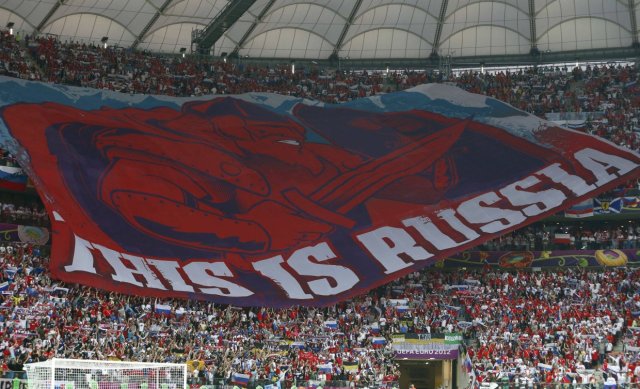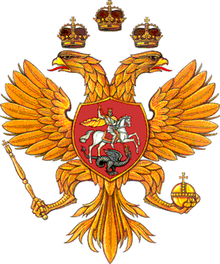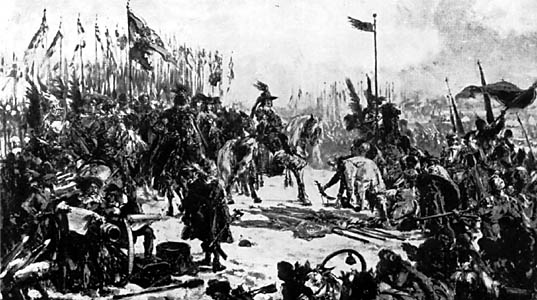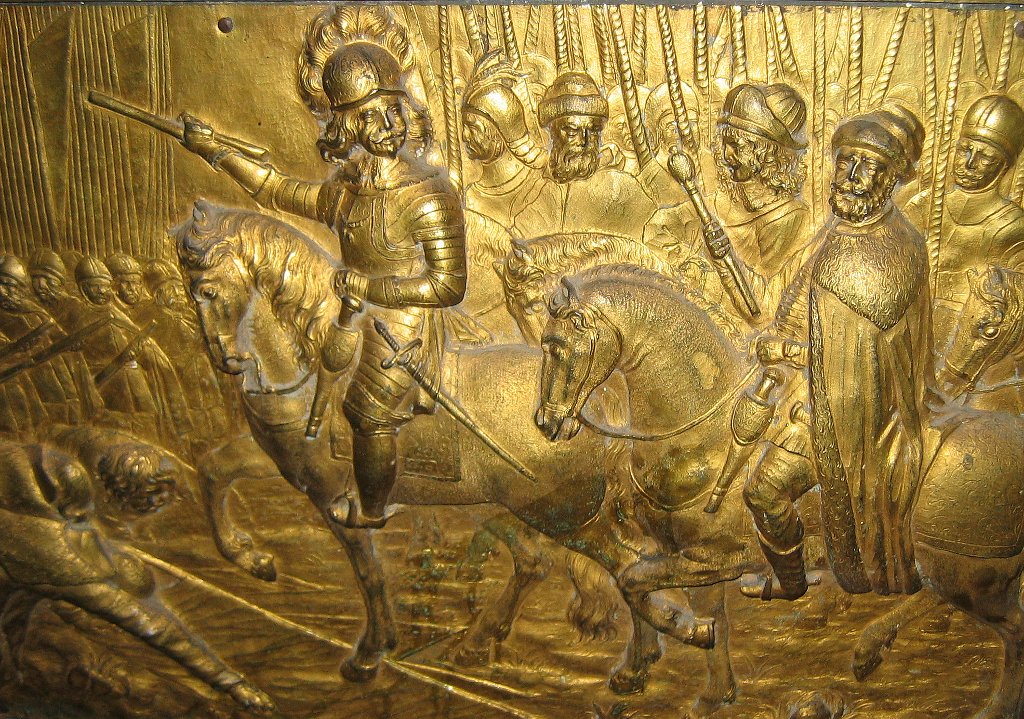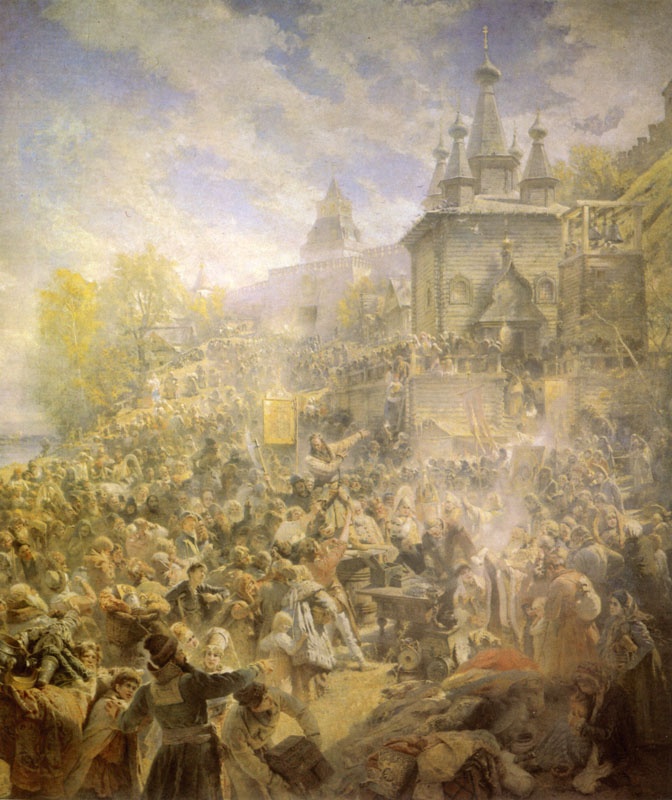© by Czesław Białczyński
© translated by Katarzyna Goliszek
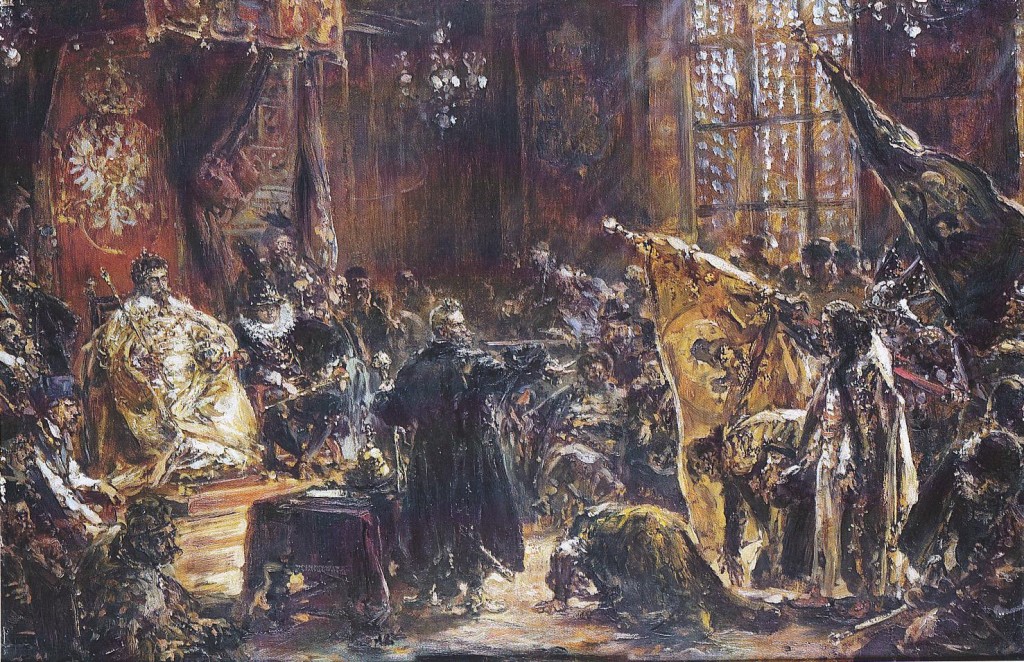 Tribute of the Russian Shuysky tsars paid to the sovereign of Poland
Tribute of the Russian Shuysky tsars paid to the sovereign of Poland
Here we quote an extract from the article published on Racjonalista.pl portal on 21 st May 2012 and we recommend the whole article to you THERE. The article is extremely important because it significantly denies historical issues – especially the background and causes of the Partition of Poland which have been demonstrated by the Catholic teaching for 250 years not in the light of the scientific truth (LST) and an analysis of the facts (AF), but in the Distorted Image of the Catholic Ideology (DICI)
This flag was unfurled in Warsaw at the match of Poland – Russia (1:1) on 12 th
June 2012 during the Euro football. In the post-communist mass media it is called
the Russian fans’ flag. It was paid for by the Association of Russia’s Fans – it is
there that money comes from to sew such flags. The provocation plotted by special
services and media in both ”friendly democracies” backfired – the ”uproar” was
an attempt of a fight between the two special services wearing colourful scarves. Of
course, they did not forget to kick the reporter of an opposition ”Gazeta Polska
Codziennie” ( =Polish Newspaper Every Day).The Polish police were passive. How
do we know it? I still remember.
A similar DICI method, instead of LST is used to present the role of the Catholic
church in restoration of the ”Independent” III rd Republic of Poland in 1989. If
We shed light on the mentioned event, however, in the informal Triumvirate we
See the Preserved people of the former Polish People’s Republic (Polska
Rzeczpospolita Ludowa = PRL) as PRL BIS = III RP with the participation of
the Catholic church. The III RP can be called mitigated where the licensed
opposition: Catholic – progressive, Catholic – pro Moscow and social democratic
syndical that de facto were allowed to express their views and to officially be in
PRL but were not permitted to take part in exercising authority. Here is all the
difference between the PRL and the III RP. Nonetheless, according to the
Catholic church,we live in an independent and a civil state.
Here is the link to the article in RACJONALISTA:WWW.Racjonalista PL
We should also remember that Moscow surrendered to the Polish for the second time on 1 st March 1634 as a result of the next defeat in the fight for Smoleńsk, but then it was escalation of mutual hatered. The picture shows the little known painting by Jan Matejko ”King Władysław IV in Smoleńsk”.
In XVI th and XVII th centuries the Republic of Two Nations was the threatening power to Russia. After the victory of Grand Field Royal Hetman Stanisław Żółkiewski at Kłuszyn in 1610 the Polish occupied the Kremlin. After signing the peace treaty in Dywilin they took away areas that had belonged to the Grand Duchy of Lithuania since XIV th century: Smoleńsk Land, Czernihiv Land and Seversk Land settlimg a new east border. Russia could not accept the defeat and made an attempt to take Smoleńsk after king Sigismund III’s death in 1632. The Polish-Russian war broke out and lasted till 1634 (so called Smoleńsk war). It ended with the victory of Polish-Lithuanian armies over Russian armies commanded by Mikhail Shein. On 25 th February 1634 the Russian army surrendered in Smoleńsk which made way for the Polish to Moscow.
[The new king of Poland Władysław IV Vasa turned out to be an excellent commander following the development of war art and cautiously applying the innovative tactic of maneuvres then which was used by the Swedish army under the command of Gustav Adolf. Władysław IV divided his army into three parts and moved deep into Russia. Polish cavalry troops went in front and arrived near Moscow wreaking havoc and terror. On 1 st March Moscow surrendered. King Władysław IV initially thought that he would enthrone his brother Jan Kazimierz in Moscow in order to attack Sweden together and regain the throne there. Growing difficulties significantly weakened the king’s optimism. Winter and diseases decimated the Polish-Lithuanian army, the end of the treaty with Sweden was coming to an end, and in the south there was a threat of war with Turkey which was allied with Russians so the Polish monarch decided to negotiate. The peace was concluded in Polanov. It confirmed the general conditions of the treaty of Dywilino: affiliation of the territories of Smolensk, Chernihiv and Seversk to the Republic of Poland. Władysław IV waived the title of the tzar of Russia and claims for the throne of Moscow.]
Władysław IV accepts the surrender of Russian forces near Smolensk in 1634 (photo by Maciej Szczepańczyk, licensed under Creative Commons Attribution 3.0)
We will be following closely Mr Agnosiewicz’s comments in Racjonalista.pl as it is about time we made reality objective in its Full Spectrum embracing all Aspects (holistically) in order to currently assess It. Without such an assessment, without a full image we will not create the possiblity of choosing rationally the Proper Ways to make a change of what is surrounding us at present.
Also, a lot is said and written about – an we will be writing about it – the relationship of the Nazis with magic, occultism, gnosis, anthroposophy and theosophy as well as the fascist references to the faith of nature, and about cult of the body, physical culture in Germany of the 30s of the twentieth century. However, very little and very reluctantly it is written about the ideological relationship of the church and the Vatican with fascism, about relationships of the Catholic church with the new authorities of PRL (the former Polish People’s Republic) after 1945 and church connexions in exchange for doing away with underground movement and conspiracy after the II nd World War, or about relationships of the Orthodox church with Stalinism and the present totalitarian regime of Moscow. We will touch upon this topic soon not to divide people but to have clarity for the future which is coming.
There are attempts in Poland to show so called Progressive Priests and Progressive Catholics from Znak, PAX, Tygodnik Powszechny and other pseudo Christain PRL’s organisations as a spontaneous movement of a handful of inconsiderate or invigilated people – it is not true. The church has not had to tolerate them, but additionally it supports this trend of cooperation with post-special services of PRL in III RP and at present.
I also recommend the text: ”Church and Republic”
CB
Milin’s Speech – Painting by Konstanty Makowski
The papacy and the birth of the Polish-Russian hatred [1]
Written by: Mariusz Agnosiewicz
For Anti memory of Piotr Skarga
Pope Paul V (1605-1621), began his pontificate by pushing Poland for anti-Russian dymitriads, one of the most stupid and most tragic episodes of our history, and ended it when his circulatory system sustained a joyous overload during the procession in honor of the massacre of Czechs in the Thirty Years’ War.
The participation of the Papacy and the Jesuits in the tragic Polish anti-Russian rows is usually passed over in silence. For Russia’s resurgent power it was a historically traumatic event that put a strain on the entire subsequent Polish-Russian relationships, and should never be ignored while remembrance of the partitions of Poland. When in 2005 Russia replaced their old national holiday commemorating the outbreak of the October Revolution with the Day of National Unity commemorating the liberation of Moscow from the Poles in Russia in 1612, the Vatican expressed concern that it could be of the anti-Catholic nature. The Pope must have worried whether the invasion of Poles and their trampling of the native culture would not be an opportunity to recall that it had been a formal crusade and the invasion aimed at making Russia Catholic again.
Polish-Muscovite War called Dmitriads
Polish occupation of Moscow was preceded by Dmitriads, i.e. the Polish-papal attempts to enthrone the usurpers of the throne of Moscow, called False Dmitriys. In the final stage of the Dmitriads, the Polish invasion and the Polish-Muscovite War (1609-1618) took place.
Pope Paul V committed himself to this project and shortly after the conclave, he played an important role in it. [1] It is not clear under what circumstances the alleged son of Ivan the Terrible turned up in Poland but it is distinctive that the first mention of him appeared on 1 st November 1603 in the Nuncio Claudio Rangoni’s letter to Pope Clement VIII. [2] The case then went to the Roman Inquisition and Camillo Borghese who worked on it and who was due to become the new Pope one and a half years later.
A few months later the False turned up before the king in Krakow, trying to convince Sigismund III Vasa to support his trip to Moscow. He agreed to marry and enthrone the daughter of the governor of Sandomierz as a tsarina. This initiative met with a devastating critique of the Polish statesman Jan Zamoyski, who considered the project of enthroning Maryna Mniszech as a tsarina worthy of Plautus’s comedy. As a result, Parliament unanimously rejected the idea of Polish involvement in this row.
The matter would certainly have been over if the nuncio and Jesuits had not engaged in it. The primate Jan Tarnowski and the Jesuits’s protector the bishop of Krakow, the later primate Bernard Maciejowski, persuaded the king to consider the Usurper favourably. [3] It was then that the conversion of the Usurper to Catholicism was agreed. The Jesuits baptised him on 17 th April 1604. On 24 th April the nuncio gave the new ”sheep” Communion and Confirmation. On the very same day the convert wrote to the pope promising him to make Russia Catholic and to organise a crusade against the Turks. In the view of Parliament’s refusal the governor of Sandomierz organised advenurous troops with the Jesuits’ support as chaplains. [5]
Several days after the conclave a letter from Rome was sent to the nuncio requesting him for a detailed report on the progress of the campaign of Dmitryi and the Polish king’s relationship towards him. Soon after that, the usurper triumphantly entered Russia. He was promised to have a triumphant fresco in the Sala Regia of Vatican. Shortly after the coronation of the new tsar, the Pope sent some official letters to: Sigismund III, Cardinal Maciejowski and the governor of Sandomierz asking them to give the new ruler of Russia all necessary assistance in the “restoration of Muscovites to Church”. It turned out, however, that the Polish king’s support for the campaign was smaller than the Jesuits were presenting it to the Pope because the king did not want to recognise the Tsar title of Dmitryi.
Russia’s new tsar established diplomatic relations only with the Vatican. On 11 th September 1605 the Pope sent him a congratulatory letter on the occasion of the coronation again reminding him of the task he was to do. In reply to the Pope’s letter, the tsar outlined his project in which he said that he would like to move with the emperor and the king of Poland on a crusade against Turks. However, in order to do so, the Pope has to urge the Polish king and send a few military experts. Paul V promised to do his best.
After some time, however, the tsar stated that his religious mission was beyond his capabilities. Polish Catholics acted in Moscow as in a conquered territory. The Pope began to lose his patience, and asked the tsar to declare war on Turkey himself and war nuncios would send the message about the war all over Europe. [6] After 11 months of the usurper’s rule, boyars made a successful plot on his life. Also at the same time a massacre of several hundred of Poles was committed. The usurper’s body was put into the cannon and fired in the direction of Poland, but it rather should have flown to the Vatican.
The Jesuits soon began to proclaim that Dmitryi had been able to escape, thus preparing the ground for a new Dmitriad. The new papal nuncio in Poland Simonetta tackled the issue. The Vatican sustained that belief. The new Dmitryi Uzurper started operations from July 1607, again supported by the Polish army. Maryna Mniszech publicly “recognized” her husband in him. There were no promises, however, to convert Russians.
Rebellion
Then the Jesuits started to have hard times in Poland. The nobles formed the Rebellion of Sandomierz against the king, and one of its main blades was aimed at the Jesuits. It was claimed that under the Jesuits’s influence the king was discriminating people of different faith – dissenters, Protestants by giving wealth, dignity, offices and constantly blocking the issue of implementing regulations for Warsaw Confederation that introduced tolearnce in Poland as well as was not responding to religious riots mainly inspired, anyway, by the Jesuits themselves. Nobility were also worried about a shift in international policy and rapprochement with the Habsburgs, who had been figting the so-called Long War under the patronage of “Holy Father” for several years against Turkey, which meant involvement of Poland in the crusade against the Turks to which the church state was pushing by granting dispensation to the Polish king to marry his former wife’s sister Constance of Austria. The Pope considered the marriage ”a thing enormously helpful to Christianity” [7]. Soon Constance became the ”main ensign of militant Catholicism” (Jasienica) cooperating with Piotr Skarga in this work. In 1606 Piotr Skarga published a propaganda pamphlet for the formation of a Christian knight (Soldier devotion). Later history showed that the nobility’s concerns were justified as Poland engaged in a costly war against Turkey after finishing the war with Moscow.
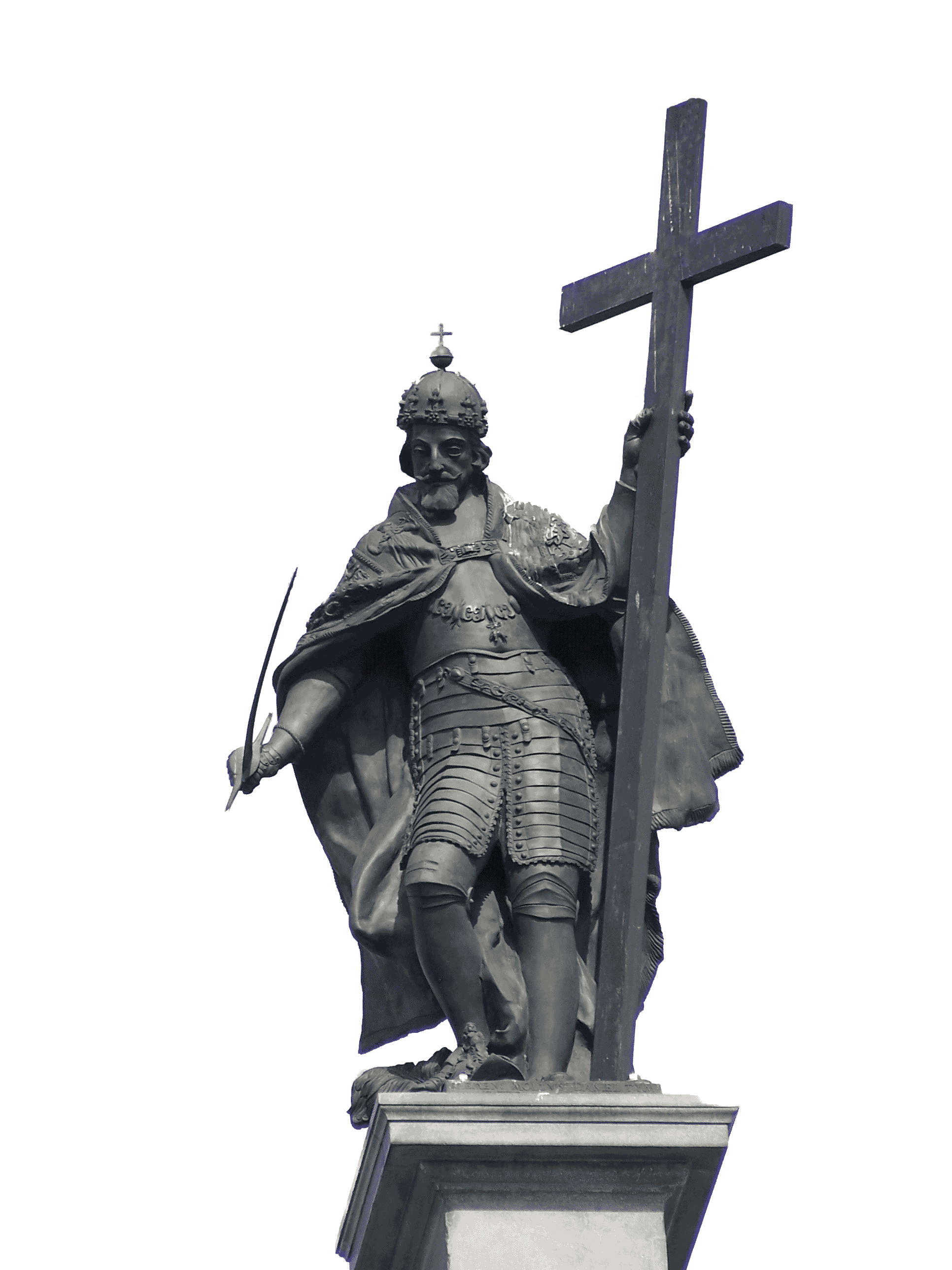 Sigismund III Column in Castle Square in Warsaw is one of the most emblematic monuments of the capital city. The king of the big cross and the sword well reflect the policy of the monarch
Sigismund III Column in Castle Square in Warsaw is one of the most emblematic monuments of the capital city. The king of the big cross and the sword well reflect the policy of the monarch
Not without reason Sigismund III was called “the Jesuit king.” The main direction of his policy in Poland making a sharp Counter Reformation course was attributed to the Jesuits, in particular to the Royal preacher, illustrious Piotr Skarga. The papal diplomat and a Jesuit Antonio Possevino (he supported the first Dmitryi Usurper), did not value the Polish ruler’s intellectual assets much. According to Antonio Possevino, the Polish ruler was ” of a slow wit and languid, not too smart temper”. From the very start of his reign Piotr Skarga as his court preacher cared about himm spiritually rousing Catholic fundamentalism in him.
Catholic historiography presents the rebellion of nobility as a movement to maintain anarchic “golden freedom”, a rebellion against strengthening of royal power which could improve the Republic. Except that this “improvement” meant suppressing Protestantism by force and next involving in the European Counter Reformatory policy and the crusade against Turkey. On the one hand, these were ”petty” interests of noblemen. On the other hand, that was the Pope’s Counter Reformatory and crusade policy. King Sigismund himself wanted to strengthen his power in order to gain the throne of native Sweden. Prince Władysław who was crowned during his father’s lifetime and a governor ruling instead of him would stay in the country…as an Austrian Archduke.
Sweden, of course, could be conquered and brought back to fidelity of Rome. Help would be given by Moscow conquered by the Usurper and induced to accept Catholicism. In this way a great northern league capable of effective actions against the Turks.would come into being. Intentions were huge and chimerical (…) His Majesty the King ”did not want to content himself with our nation. He strove for total victory of Catholicism in the whole Europe distroying ethical integrity of the state that had been relaible for ages, and for the Swedish crown for himself. The Republic was supposed to comply with all those aims and serve like a springboard” (Paweł Jasienica). The anti-royal opposition fought with such a trend.
…
further reading: WWW. Racjonalista.pl
Tagged with: Counter-Reformation, Poland, causes of the collapse of the First Republic, friendship, Russian, Partitions of Poland, Sigismund III Vaza

